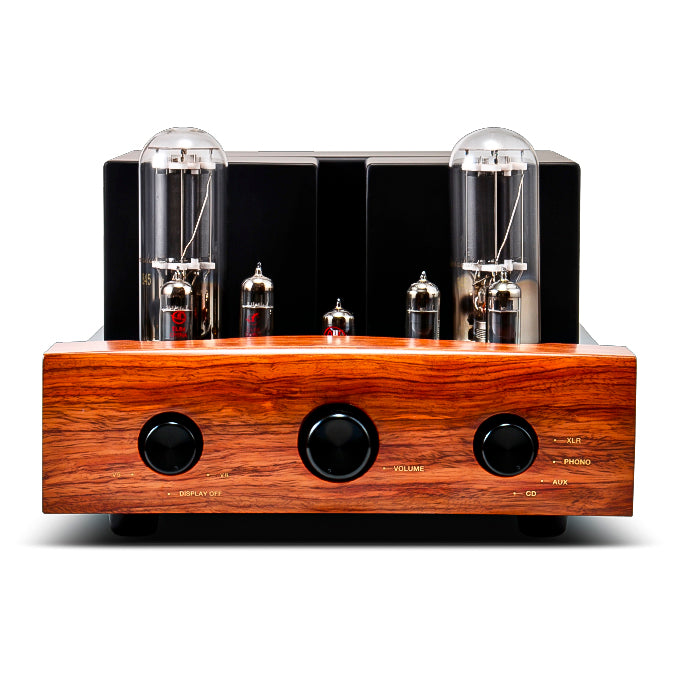Music is listened to in various ways, but the minimum equipment required to listen to good music is a player, speakers, and amplifier.
Players are now smartphones and tablets that play iTunes and Amazon music, CD players, and record players that play analog records. Speakers are also familiar to everyone. Then there is the amplifier, which amplifies (amplify) the music signal input from the player and switches between multiple music signals. Only when these three pieces of equipment are in place can a good sounding music listening environment be created.
If you are an audio novice, you may know what speakers are, but what is an amplifier? If you are an audio novice, you may know what speakers are, but what is an amplifier? If you have a player and headphones, you can listen to music.
So, what is an amplifier? Here we go.
An amplifier is a device that makes the sound better before it comes out of the speakers.
Generally, the music signal output from a player is very small, so an amplifier amplifies the small music signal to a level where it can be heard through speakers. What is important in the audio world is how the reproduced sound signal is delivered to the ear in its original form. In reality, however, each amplifier has its own sound characteristics, such as high frequency range, low frequency range, warmth or coolness, etc. There are various types and characteristics from digital amplifiers to tube amplifiers. Finding an amp that suits your taste and music genre is one of the pleasures of audio.
In any case, amplifiers that amplify sound signals are indispensable for enjoying music with "good sound.
Preamplifier and Power Amplifier?
Amplifiers can be broadly classified into two types: preamplifiers and power amplifiers.
PreamplifierA "preamplifier" is an amplifier that can be connected to an input music player (smartphone, CD, record player, etc.) at the same time, and is used to select which device to listen to music with and to adjust the sound quality and volume. Although it is called an amplifier, it does not amplify the signal level and does not have terminals for connecting speakers. Therefore, if you have only one choice of playback device to connect, or if you do not need an equalizer function for listening to records, you do not need a preamplifier as long as the power amplifier has a volume control (if you use a smartphone or tablet, you do not even need a volume control). However, to honor the preamplifier, the music signal reproduced by a preamplifier is beautifully arranged, and it is a reliable presence that can evolve a step or two toward a rich and lustrous tone from the high to low frequencies.


The role of the preamplifier is to amplify the music signal sent from the preamplifier or player so that the sound can be produced from the speakers.Power AmplifierThe power amp is responsible for amplifying the music signal sent from the preamplifier or player so that sound can be produced from the speakers. The power amplifier then transmits the sound to the speakers. The power amplifier literally amplifies the signal to drive the speakers so that the music can be heard. Most power amplifiers have a power supply section that is reinforced and incorporates a large, heavy transformer in order to generate the driving power. The power amplifier's ability to drive a speaker depends on the power of the amplifier. If the amplifier is not powerful enough to drive the speakers, the speakers will not be able to show their true potential, and if the amplifier is not powerful enough to drive the speakers, the sound will be unsatisfactory. In both cases, the ideal sound that can be expressed originally cannot be heard. It is necessary to select speakers with specifications that match each other to some extent in order to enrich your musical life.


As mentioned above, an amplifier with independent preamplifier and power amplifier is called a separate type amplifier. Separate-type amplifiers allow you to enjoy more fun in pursuit of your own favorite sound by combining different manufacturers' products for each.
Click here for the page of preamplifiers
https://www.exclusive-audio.jp/shop/products/list.php?category_id=29
Power Amplifierpage is here
https://www.exclusive-audio.jp/shop/products/list.php?category_id=28
The pre and power sections are integrated into a single unit.Pre-Main AmplifierorIntegrated Amplifieror "integrated amplifier". Each manufacturer offers a lineup of power amplifiers with volume control by omitting a part of the preamplifier section, so it is possible to use one as a main amplifier.
For example, aCAP-1001 by Bakun Products
This power amplifier with volume control is small enough to be used on a desktop. There are two input systems: RCA jacks on the rear panel and a phone jack on the front panel. The front input can be used to connect a mobile player, smartphone, or other device, so you can connect it to the CAP-1001 as soon as you get home and enjoy high-resolution music as much as you like. Although small, the sound is full-fledged, and the device delivers a wonderful sound that you would never expect from its appearance.
Click here to see the page of this product
https://www.exclusive-audio.jp/shop/products/detail.php?product_id=587

Astro Electronics TO-KT88KGIN
Tube power amplifier with three input systems and volume control. This is a full-fledged model that allows you to enjoy players other than vinyl records, such as CDs, cassette decks, smartphones, and tablets without a preamplifier.
Click here to go to the page of this product
https://www.exclusive-audio.jp/shop/products/detail.php?product_id=633

Yoshishiba Acoustics 50single
This is also a power amplifier with volume control. This amp is full of tube amp craftsmanship with emphasis on low-frequency expression.
Click here to see the page of this product
https://www.exclusive-audio.jp/shop/products/detail.php?product_id=133

And now, a tube amp that combines retro and futuristic senses.
What kind of tube amps do we carry in our store?
It is an amplifier that uses vacuum tubes to amplify signals. However, the demand for vacuum tubes, which are three expensive tubes that consume heat, production, and space, has decreased, and transistors, which are inexpensive and highly productive, have replaced them in a variety of electrical products. Audio equipment, as usual, became dominated by transistor-based products, and the number of vacuum tube-based amplifiers has drastically decreased to the extent that only small- and medium-sized audio manufacturers are producing them.
The general image from the past was that transistor amplifiers had a 'cold sound' and 'lacked the softness and warmth characteristic of vacuum tubes' compared to vacuum tube amplifiers, with vacuum tube amplifiers having a warm, retro sound and transistor amplifiers having a sharp, modern sound, but now, in fact, I I think it is safe to say that there is no such feeling. First of all, the precision of transistors, capacitors, and other internal components has improved dramatically, and at the same time, technology has advanced by leaps and bounds. Whether it is a vacuum tube or a transistor, the sound is supposed to be clear, transparent, and free of impurities.
Manufacture of tube amplifiersAstro Electronic Planningamps are very precise, sophisticated, and transparent, and are different from the image of conventional tube amplifiers. This is because Astro Denshi Kikaku's policy is to "faithfully reproduce the original sound.
Click here for Astro Electronic Planning products
https://www.exclusive-audio.jp/shop/products/list.php?category_id=18

which also manufactures amplifiers using proprietary IC chips.Bakun Productshas been acclaimed by audiophiles and audio magazines around the world for its overwhelming transparency and detail in sound reproduction. This company also has a policy of "faithfully reproducing the original sound.
Click here for Bakoon Products products
https://www.exclusive-audio.jp/shop/products/list.php?category_id=17

On the other hand, Baccoon Products also has its own brand of sound creation, "Enjoying the sound of tube amplifiers and music should be like this! On the other hand, there are also brands that create their own unique sound.
a manufacturer of tube amplifiers.Yoshishiba AcousticsYoshishiba Acoustics reproduces the sensitivity of the tube amp sound of the past to a higher dimension with modern technology, while at the same time creating a sound that is very bass-conscious, as jazz is all about bass, and it is a very pleasant sound that lifts one's spirits when listening to it.
Click here for Yoshishiba Acoustics products
https://www.exclusive-audio.jp/shop/products/list.php?category_id=42

And the world famous and very popularYamamoto Acoustic CraftsThe delicate, warm sound with a rich midrange may be the image of a very tube-like sound.
Click here to see Yamamoto Acoustic Craft's products
https://www.exclusive-audio.jp/shop/products/list.php?category_id=13

Tube amplifiers come in a variety of designs that make use of vacuum tubes, from retro designs to futuristic designs. You can enjoy choosing one to match your interior design.
The manufacturers we carry are all handcrafted by amp craftsmen and designers scattered all over Japan, just like rockets in downtown Tokyo.
Tube amplifiers are much easier to handle nowadays. No difficult adjustments are required, and even beginners can enjoy them with ease.
We recommend these amps to everyone from those who have just started to enjoy audio to seasoned audiophiles and those who have been away from audio for a while but want to listen to good sound again.

























